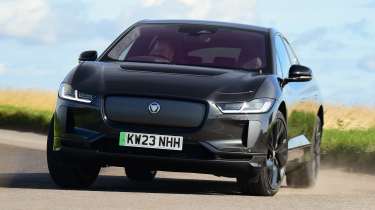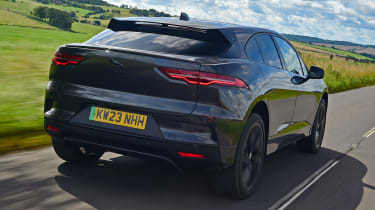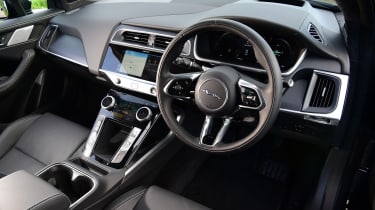Jaguar I-Pace 2023 review
The I-Pace has been on sale for five years, and new rivals are homing in – does Jag’s EV trailblazer still cut it in 2023?
The Jaguar I-Pace famously beat the Germans to the electric car punchline in 2018. This totally bespoke, skateboard-chassis electric crossover arrived ready to revolutionise the class, not to mention the modern Jaguar buyer.
But how time flies. Five years later, Jaguar has pretty much stood still while more sophisticated, more efficient EVs close in from all sides to leapfrog the I-Pace. And this threat has only become more acute in the last two years or so, particularly with the supremely refined and luxurious BMW iX raising the stakes as the new electric SUV benchmark.
In response, Jaguar…hasn’t responded much at all. As part of an update for 2024, the I-Pace has received a selection of very subtle cosmetic changes (a new front grille blanking plate and exterior trim accents), and a realigned trim structure. The range now comprises four specification levels, kicking off with the £69,995 R-Dynamic S and rising up to a new flagship 400 Sport model for £79,995. The motor and battery tech is the same as before and shared across the lineup, with a hike in standard equipment as you climb up the ladder.
With an electric motor mounted at each axle, peak power is rated at 395bhp, with a combined torque figure of 513lb ft. Despite a 2151kg kerb weight, the I-Pace’s raw acceleration figures still stack up well in 2023, with the 0-62mph sprint dispatched in 4.8sec – that’s some way off a Tesla Model Y Performance, but 1.3sec quicker than the similarly-priced BMW iX xDrive40.
More reviews
Reviews
But in an age where pretty much every premium electric car has enormous performance reserves for everyday use, other elements are more critical – namely range. The I-Pace’s 90kWh battery pack is mounted in its underbelly and offers up to 286 miles of range, which plummets to 261 miles when fitted with 22-inch wheels (as with our test car). In warm weather conditions we got surprisingly close to this, achieving 249 miles from a charge, but that’s still some way behind cheaper purpose-built EVs like the Kia EV6. A peak charging rate of 100kW is also off the pace these days.
Part of what made the I-Pace such a breakthrough on its release was its chassis; it was the first application of a skateboard-style platform from a legacy car company. It caught all of us by surprise, especially its German rivals, as the advantages of building an EV from the ground up yields a whole world of benefits – and the I-Pace continues to take advantage of these.
This is seen first and foremost in its proportions, with a cab-forward design that makes full use of the I-Pace’s footprint to create a large, spacious cabin area. A low centre of gravity, general simplification of the floor and battery placement are other pluses – it was a breakthrough for Jaguar in 2018, even if this style of architecture is commonplace now.
When Jaguar’s calibration engineers began development work on the I-Pace they were tasked with making it ‘feel like a Jaguar’, and considering it shares so little with its traditional counterparts the I-Pace does drive remarkably like a Jaguar saloon. There’s a reassuringly accurate and intuitive feel to almost everything it does, which is no mean feat given that this is a heavy, pseudo-crossover spanning more than two metres wide.
It starts with the driving position. It doesn’t feel truly purposeful in that you’re sitting on top of the battery pack rather than skimming the ground, but the relationship between the steering wheel, pedals and seat (lifted from the Jaguar Project 8, no less) is almost spot on. As long as the I-Pace’s slightly irritating virtual driving sounds are switched off, it immediately delivers a level of refinement and structural integrity that feels distinctly Jaguar-like – the body feels flat and the centre of gravity low, with none of the disconcerting vertical float you might find in other air-sprung crossovers.
The 400 Sport model we tested pairs adjustable air suspension with adaptive dampers, the latter of which can be switched between comfort and dynamic settings independently of the powertrain and steering parameters. The softer mode is rarely wanting for control and offers a more relaxed response over high frequency bumps, but it doesn’t iron out the persistent fidget that can occasionally disturb the ride over gnarly roads.
The I-Pace is never harsh and the dampers deal with bigger hits in one neat sweep, but the BMW iX is noticeably more cushioned and absorbent. In particular, there’s a fair bit of jostling across the axles; it feels like an active anti-roll bar system would mitigate some of this, enabling each wheel to isolate bumps from the other side of the car.
Crucially though, the direct ride feels engineered into the car and its responses, and falls short of being uncomfortable. The crisp, linear reactions from the steering are in tune with the tightly controlled body movements, and the I-Pace slices into and through a corner in one slick movement. Both axles find supreme traction on the way out too, and while the overbearing sense of mass can be unnerving at higher speeds – particularly on the brakes – there’s clear shared dynamic DNA between the I-Pace and other Jaguars.
It’s also supremely fast. Not to stomach-churning Tesla levels, but the instant thump of torque is enough to pile on speed at a startling rate for what is otherwise a sensible family crossover. Speaking of which, the I-Pace gets most of the sensible stuff right. Inside, there’s an attractive blend of traditional elements (including, thankfully, physical temperature controls) and more EV-specific architectural cues, with the windscreen extending far ahead to provide a more airy feel. The trouble is, the design and build – while premium – fall flat when compared to the BMW iX’s more sumptuous, sculptural cabin. The new I-Pace uses the same Pivi Pro infotainment system as before, and it isn’t a patch on BMW’s iDrive for speed, responsiveness and functionality, either.
Price and rivals
At £69,995, the I-Pace competes squarely against the BMW iX xDrive40, and despite its comparative age, the numbers stack up favourably for the Jag; it’s more powerful, significantly quicker and offers an extra 24 miles of range. The trouble is, the iX’s key advantages – namely its exemplary refinement, ride quality and technology suite – leave the Jaguar feeling last gen. The BMW’s 150kW maximum charging speed is also 50 per cent faster than the I-Pace’s.
Life will probably be even harder for the I-Pace next year, when the first PPE platform-based EVs from Audi and Porsche begin to arrive. The new all-electric Macan will adopt a sleeker coupe-style body when it goes on sale in 2024, and if the Taycan is anything to go by, it’ll prove a stern test for the I-Pace dynamically. The Audi Q6 e-tron is also scheduled for next year with the same underpinnings, but with a lower starting price than the Porsche.
The fervent competition in the lower end of the EV market means that the I-Pace also faces tough competition from the likes of Hyundai and Kia. In £58,830 dual-motor long range spec, the Ioniq 5 offers around 300 miles of range and class leading 350kW charging speeds, with the £62,645 Kia EV6 GT using the same platform in a more dynamic, 577bhp package. Neither feel quite as premium as the I-Pace, but they aren’t miles away – Jaguar will be conscious of these cheaper models nipping at its heels.









